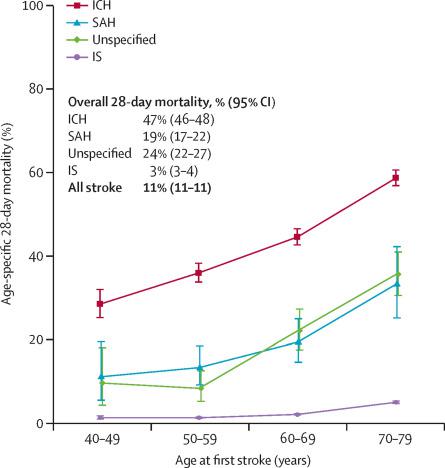The Lancet Global Health ( IF 19.9 ) Pub Date : 2020-03-18 , DOI: 10.1016/s2214-109x(20)30069-3 Yiping Chen 1 , Neil Wright 2 , Yu Guo 3 , Iain Turnbull 4 , Christiana Kartsonaki 1 , Ling Yang 1 , Zheng Bian 3 , Pei Pei 3 , Dongxia Pan 5 , Yidan Zhang 5 , Haiqiang Qin 6 , Yilong Wang 6 , Jun Lv 7 , Ming Liu 8 , Zilong Hao 8 , Yongjun Wang 6 , Canqing Yu 7 , Richard Peto 2 , Rory Collins 2 , Liming Li 9 , Robert Clarke 2 , Zhengming Chen 1 ,

|
Background
Stroke is a leading cause of death and disability worldwide. Despite considerable improvements in diagnosis and treatment, little is known about the short-term and long-term prognosis after a first stroke in low-income and middle-income countries, including China. We aimed to assess the short-term and long-term risk of recurrent stroke and mortality after a first stroke for each of the major pathological stroke types.
Methods
This population-based cohort study included adults aged 35–74 years without disability who were recruited to the China Kadoorie Biobank (CKB). A baseline survey was conducted in ten geographical areas (five urban, five rural) in China, and participants had clinical measurements recorded. Participants were followed up by monitoring death registries and by electronic linkage to health registries and health insurance claims databases, with follow-up until Jan 1, 2017. Participants were excluded from analyses if they had a previous history of stroke, transient ischaemic attack, or ischaemic heart disease at baseline. All incidences of fatal and non-fatal stroke during the study period were recorded by type (ischaemic stroke, intracerebral haemorrhage, subarachnoid haemorrhage, and unspecified type). Primary outcome measures were 28-day mortality, recurrent stroke, major vascular events (recurrent stroke, myocardial infarction, or vascular death), vascular mortality, and all-cause mortality.
Findings
Of 512 715 individuals in the CKB, 489 586 participants without previous ischaemic heart disease and stroke at recruitment were included, of whom 45 732 (42 073 [92%] confirmed by brain imaging) had a stroke during the study period. The mean age was 59·3 years (SD 9·8) for participants who had a stroke (54% women) and 50·8 years (10·3) for participants with no stroke (60% women). 36 588 (80%) of the incident cases of stroke were ischaemic stroke, 7440 (16%) were intracerebral haemorrhage, 702 (2%) were subarachnoid haemorrhage, and 1002 (2%) were an unspecified stroke type. 28-day mortality was 3% (95% CI 3–4) for ischaemic stroke, 47% (46–48)for intracerebral haemorrhage, 19% (17–22; 52% for rural areas and 32% for urban areas) subarachnoid haemorrhage, and 24% (22–27) for unspecified stroke. Among participants who survived stroke at 28 days, 41% (41–42) had recurrent stroke at 5 years (ischaemic stroke 41% [41–42], intracerebral haemorrhage 44% [42–46], subarachnoid haemorrhage 22% [18–27], unspecified stroke type 40% [35–44]) and mortality at 5 years was 17% ([17–18] ischaemic stroke 16% [15–16], intracerebral haemorrhage 28% [26–29], subarachnoid haemorrhage 16% [12–20], unspecified stroke type 15% [12–19]). After a first ischaemic stroke, 91% of recurrent strokes were also ischaemic stroke; after an intracerebral haemorrhage, 56% of recurrent strokes were intracerebral haemorrhage, and 41% of recurrent strokes were ischaemic stroke.
Interpretation
After a first stroke, the risk of recurrence or death within 5 years was high among this population of Chinese adults. Urgent improvements to secondary prevention of stroke in China are needed to reduce these risks.
Funding
Wellcome Trust, Medical Research Council, British Heart Foundation, Cancer Research UK, Kadoorie Charitable Foundation, Chinese Ministry of Science and Technology, National Natural Science Foundation of China.
Copyright
© 2020 The Author(s). Published by Elsevier Ltd. This is an Open Access article under the CC BY 4.0 license.











































 京公网安备 11010802027423号
京公网安备 11010802027423号